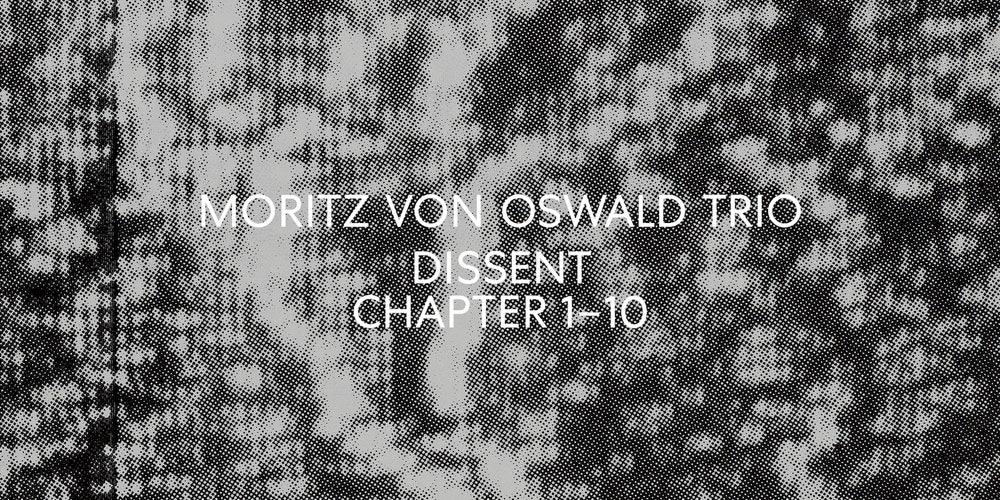Moritz von Oswald has never cared much for the spotlight. In the early 1990s, his duo Basic Channel, with Mark Ernestus—and their whack-a-mole-like series of aliases Maurizio, Quadrant, Cyrus, and Round One through Round Five—were notorious for their tight-lipped nature. It figures that the Berlin duo’s contribution to club music was to project a brash, ebullient genre like techno through dub, a musical style that speaks in shadows. When von Oswald and Ernestus finally got around to putting vocals in their music, in the ambient-dub group Rhythm & Sound, they remained in the background, fingers pressed to the mixing desk, while singers like Paul St. Hilaire and Cornell Campbell took the mic. Even in the trio that bears his name, von Oswald has kept his head down. In the group’s early years, all three players’ input—Max Loderbauer’s amorphous modular synthesizer, Sasu Ripatti’s metallic percussion, and von Oswald’s hazy electronic treatments—came together in a porous weave in which no one voice stood out; pull any thread, and the whole thing would come apart.
On the group’s last album, 2015’s Sounding Lines, Ripatti ceded his seat to Tony Allen, the legendary Afrobeat drummer, and not only did the group’s sound shift, but so did its center of gravity. Allen wasn’t the star, exactly, but his drumming came to the fore; whole universes of biomorphic detail sprang into being in the tiny slivers of space carved out by his crisply controlled timing. Led by Allen’s more muscular sticks, the group sloughed off some of the ambient fog of its first three studio albums, digging into meatier jazz-funk fusions. On the Trio’s first album in six years, a double lineup change reshuffles the deck yet again, and the result is a record unlike anything in the group’s catalog.
Previous albums from the Trio were not quite techno, nor dub, nor jazz; you might call them “fourth stream,” after Gunther Schuller’s so-called third-stream synthesis of jazz and classical. Dissent continues down that hybrid channel, but it is also the jazziest album the group has made. Some of that comes down to Heinrich Köbberling, who has the unenviable task of filling Allen’s seat behind the kit. (Allen, whom Brian Eno called “perhaps the greatest drummer who ever lived,” died in April 2020, at 79.) A member of the ECM-signed Julia Hülsmann Trio, Köbberling has a lighter, more glancing touch than Allen did: While von Oswald’s steady drum programming drives the groove forward, Köbberling traces its edges, toying with slight shifts in direction and intensity. In “Chapter 2,” he turns a syncopated cowbell pattern into a taut rubber band; in “Chapter 1,” a thick swirl of electric jazz that confirms von Oswald’s fondness for fusion-era Miles Davis and Herbie Hancock, he focuses his energies on tight fills that tear across the perimeter like dust devils.
But the real surprise on this record is Laurel Halo. The American-born musician is one of the most versatile figures in experimental music, with a catalog encompassing otherworldly electronic pop, razor-sharp club cuts, digitally deconstructed piano etudes, and post-classical soundtrack work. But she has never sounded like this: Replacing Loderbauer’s spongy modular-synth tones with the bright colors of the Wurlitzer organ and Rhodes electric piano, she takes over the music’s tonal center, laying out blocky chords and laying into smooth, elliptical runs. The Moritz von Oswald Trio has typically preferred a tenebrous palette—charcoal, gunmetal, petrol—but in Halo’s hands, the midrange is awash in berries and opals and blood, glistening against the darkness of von Oswald’s sullen bass synths.
As on previous albums from the Trio, the overarching vibe remains murky and muddled, like a strong joint on top of a hangover on a humid, overcast day. But they cover more range than ever before, answering the stiff-jointed frug of chapters 1 and 2 (all 12 tracks are untitled) with the diaphanous ambience of “Chapter 3,” and balancing the cobwebbed dissonance of “Chapter 6” with the wide-open spaces of “Chapter 7,” in which rainforest recordings are mirrored by Köbberling’s own cicada-like castanets. And if the tempo sometimes seems reluctant to get on its feet, they slip into a sleek dance groove on “Chapter 5,” a graceful fusion of deep house and dub techno. Contrasted with the album’s preponderance of sour, coppery tastes, it’s an ice-cold glass of sparkling water.
“Chapter 5”’s supple rhythm and rich, consonant tones mark it as one of the most immediate and inviting things that von Oswald has done in years. But some of Dissent’s more abstract moments are almost as thrilling. Closing out the album with “Epilogue,” they seem to pull apart everything they’ve so carefully constructed over the preceding 71 minutes, stretching Halo’s keys like taffy over an elastic, Villalobos-esque beat of flickering hi-hats and ungainly lumps of tone. In moments like this, it becomes clear that the record’s chief pleasures are neither its rhythms nor its melodies but rather what happens in the spaces in between, where von Oswald’s dub techniques tug his players’ sounds out of their customary orbits. Tones stretch; drum hits collide. In the shadows, sparks fly.
Buy: Rough Trade
(popitrecords.com.)
Catch up every Saturday with 10 of our best-reviewed albums of the week. Sign up for the 10 to Hear newsletter here.
